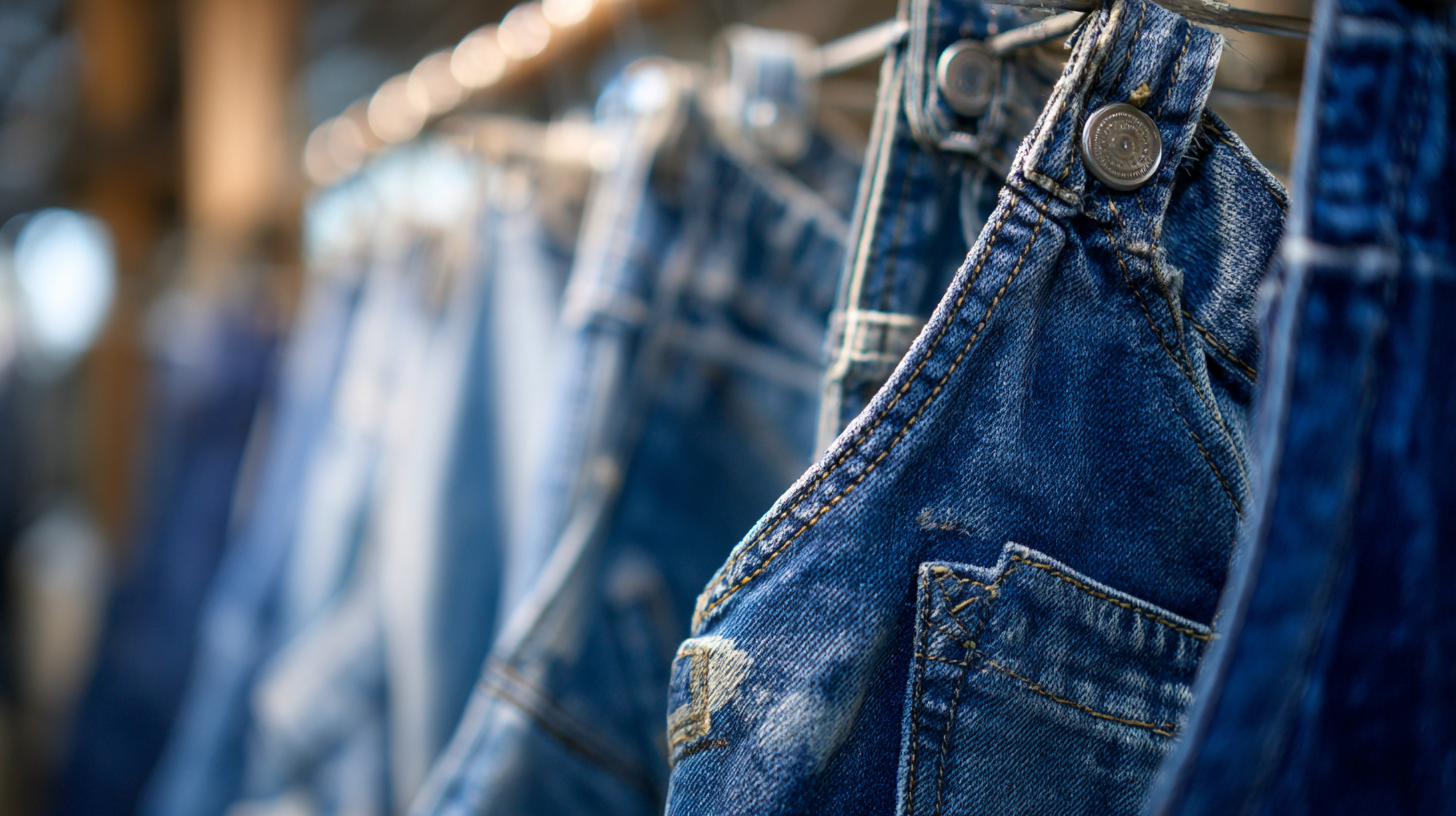Welcome to the TopShow!Garment manufacturing !
OEM, ODM Service,Custom color Custom logo,Custom Your Own Brand Online!
Welcome to the TopShow!Garment manufacturing !
OEM, ODM Service,Custom color Custom logo,Custom Your Own Brand Online!
The global demand for denim fashion continues to soar, with the denim market projected to reach USD 76 billion by 2025, driven by a resurgence in casual wear and sustainable practices. Among the trending items, the "Denim Washing Jumpsuit" has emerged as a versatile wardrobe staple, appealing to consumers looking for both style and comfort. This adaptable garment has gained popularity, reflected in a reported 15% increase in searches over the past year, highlighting its growing status in fashion circles. As manufacturers in China refine their craftsmanship and innovative washing techniques, they not only enhance product quality but also cater to an increasingly eco-conscious consumer base. This blog will explore the journey of crafting excellence in denim jumpsuits, from production in China to global markets, underscoring key trends, techniques, and the significance of sustainability in the evolving denim landscape.

The global denim jumpsuit market has witnessed significant growth, driven by rising consumer demand for stylish and versatile clothing options. According to a recent report by Statista, the denim apparel market is projected to reach approximately $72 billion by 2025, highlighting the increasing relevance of quality manufacturers in the industry. When identifying top denim jumpsuit manufacturers, several key qualities stand out. These include superior fabric sourcing, innovative design, and sustainable production practices.
Tip: Look for manufacturers who prioritize eco-friendly materials, as 66% of consumers are more likely to choose brands that demonstrate a commitment to sustainability. Manufacturers who invest in high-quality denim fabrics not only improve product durability but also enhance the overall aesthetic.
Moreover, a robust supply chain and nimble production capabilities are crucial for meeting market demands. A study by McKinsey indicates that brands with agile supply chains can reduce lead times by 30% and increase their responsiveness to fashion trends.
Tip: Partnering with manufacturers that utilize advanced technologies like 3D prototyping can significantly expedite the design process while ensuring substantial cost savings. This combination of quality, sustainability, and efficiency can elevate a brand’s position in the competitive denim market.
| Quality Attribute | Description | Importance Rating (1-5) | Example Measurement |
|---|---|---|---|
| Fabric Quality | Use of high-grade denim with durability and softness. | 5 | Tensile strength: 50 N/mm² |
| Sustainability Practices | Eco-friendly processes and materials used in production. | 4 | Water usage: 20 liters per unit |
| Craftsmanship | Attention to detail in stitching and finishing. | 5 | Stitch count: 10 stitches per inch |
| Fit and Comfort | Design considerations for body shape and ease of movement. | 4 | Inseam depth: 29 inches |
| Innovation | Incorporation of modern techniques and materials. | 5 | Use of stretch denim for flexibility |
When considering sourcing denim jumpsuits, it’s crucial to ask potential suppliers a series of essential questions to ensure quality, reliability, and compatibility with your vision. Start by inquiring about their manufacturing processes. Understanding how a supplier fabricates their denim, including the techniques used for dyeing and finishing, can provide insights into the sustainability and durability of their products. It's equally important to discuss their capacity for meeting your order sizes and timelines. Suppliers should be able to accommodate both large and small orders while maintaining a consistent turnaround.
Next, delve into the specifics of their quality control measures. Ask about the standards they adhere to and the testing methods employed to ensure that each batch of denim jumpsuits meets your quality expectations. Inquire about their certification processes—having certifications can be a strong indicator of their commitment to quality manufacturing practices. Lastly, don’t overlook the importance of flexibility and communication. Find out how they handle changes in order specifications and their responsiveness to inquiries, as these factors can significantly impact your overall experience as a buyer.

The denim industry is undergoing transformative shifts, particularly in regions like Gujarat, where a vertical growth pattern is emerging. Driven by changes in global procurement and enhanced benefits under local textile policies, manufacturers are increasingly optimizing supply chains to maximize efficiency and sustainability. This evolution reflects a broader trend in which supply chains are no longer seen merely as operational components but as strategic assets essential for competitive advantage in the global market.
As industry players navigate these adjustments, the commitment to sustainability remains paramount. The push towards decarbonization is reshaping production processes, with significant goals set for emission reductions. This aligns with an increasing consumer preference for environmentally conscious practices, prompting brands to rethink their approaches to sourcing and manufacturing. The focus on circularity is further exemplified by initiatives aimed at promoting sustainable practices throughout the supply chain, emphasizing the need for collaboration across industries to meet future challenges and opportunities.
In recent years, the global fashion industry has increasingly prioritized sustainability, and denim jumpsuit suppliers are no exception. Evaluating their sustainability practices reveals a spectrum of approaches in the production process, from sourcing raw materials to manufacturing techniques. Many suppliers in China are adopting eco-friendly materials such as organic cotton and recycled fibers, which significantly reduce the environmental impact associated with traditional denim production. By integrating these sustainable materials, brands not only minimize waste but also appeal to a growing demographic of environmentally-conscious consumers.
Moreover, the production processes employed by denim jumpsuit manufacturers have evolved to incorporate water-saving technologies and energy-efficient machinery. Some suppliers are investing in innovative dyeing techniques that use less water and harmful chemicals, thereby lessening their carbon footprint. Additionally, initiatives such as waste recycling and eco-friendly packaging are becoming prevalent, showcasing a commitment to sustainability at every production stage. As consumers increasingly demand transparency and ethical practices, evaluating these suppliers’ sustainability efforts is critical for brands aiming to position themselves as responsible players in the global market.
In the increasingly competitive world of denim jumpsuit manufacturing, leveraging trade shows and online platforms has become essential for supplier research. Trade shows offer unparalleled opportunities for brands to connect with potential suppliers, assess product quality, and establish partnerships. These events are not just about showcasing garments; they represent a significant convergence of innovation, creativity, and networking in the textile industry. By attending relevant trade shows, manufacturers can stay informed of emerging trends and technologies, ensuring they remain at the forefront of the denim market.

Meanwhile, online platforms have revolutionized supplier research, providing businesses with access to a broader range of vendors and manufacturers across the globe. The rise of e-commerce has transformed how products are sourced and sold, facilitating faster decision-making and enabling brands to compare options efficiently. Virtual events, which have gained traction recently, further enhance this landscape by allowing companies to interact, negotiate, and collaborate without geographic limitations. By effectively combining both trade shows and online resources, denim jumpsuit brands can optimize their supplier search and foster greater innovation, ultimately enhancing the quality of their products while reaching global markets.
